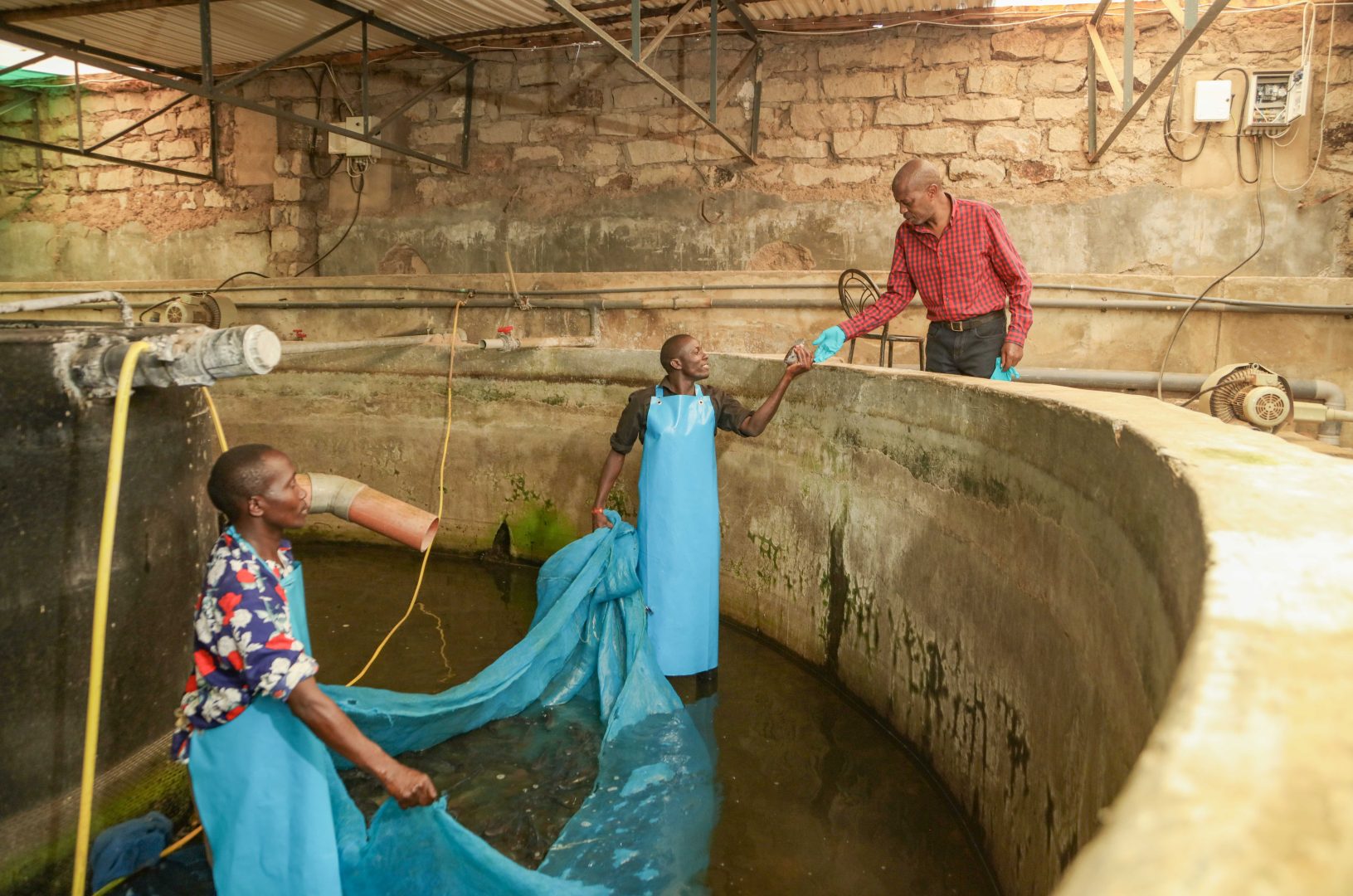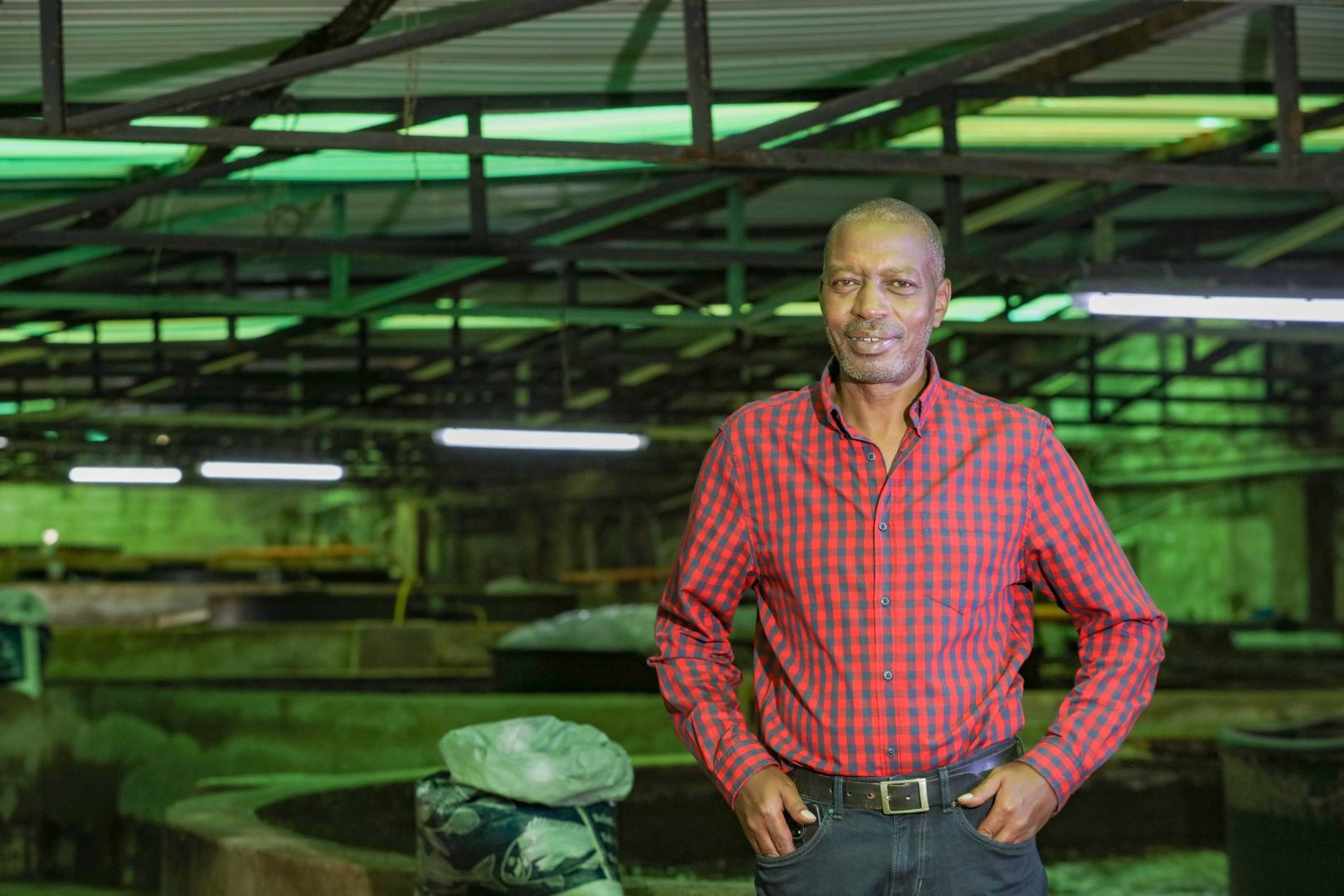Machakos is predominantly a dry area with limited rainfall throughout the year. However, agricultural products such as mangoes, oranges, lemons, cereals, and tubers like cassava, thrive in the area.
In 2015, Antony Ndeto, a resident of Kamuthanga at the foot of Mua Hills, decided to venture into something different. At the time he was into horticultural farming, which was already thriving.
The extra space on his land and the lucrative market in the nearby city of Nairobi gave him the impetus for the new venture. Mr. Ndeto then set up Kamuthanga Fish Farm to meet the growing demand for fish and help bridge the country’s production gap.
The primary pre-requisite for fish farming is water. Most aquaculture farmers have ponds for fish farming. However, Mr. Ndeto decided to set up a Recirculating Aquaculture System, also known as the RAS system, for his farm, enabling him to use water sustainably while also reducing the maturity period of fish from eight months to four months.
“Probably we are the biggest RAS farmers in sub-Saharan Africa. It is not used in such areas because many farmers may not meet the requirements of stable water and power supplies. You need to put measures to mitigate the situation if there is a power shortage or lack of water. However, on our side, we have been able to mitigate these factors to ensure the system works,” says the farm’s managing director.
The farm has three sections that facilitate fish growth in different stages. The fish’s journey begins in the hatchery, where the eggs hatch. The fingerlings are harvested and taken to the nursery section. Here, they mature and are then transferred to the growth section where upon maturity, they are harvested on demand.
The RAS system has been significant to this process’s success. It ensures a continuous supply of water across the different sections. The farm can produce fish continuously throughout the year and has enabled Mr. Ndeto to supply fish continuously.
According to the farm’s manager, Alfred Maina, they get their water from a borehole; however, the recirculating aquaculture system ensures that water is utilised optimally.
“The little water we get from the borehole is used in our different systems in three departments: the incubator, the nursery, and the growth section. We circulate that water, whereby the water from one section is fish to remove both dissolved waste and solid waste and then aerated before coming back to the fish. The water in our growth section runs within the system for four months, and our fish can continue to grow with the same amount of water,” said Mr. Maina.
To ensure fresh water for the fish throughout the process, Mr. Maina and his team do flooding, where 10% of the utilised water is removed and replaced with fresh water to nourish the system.
The main part of this type of farming is ensuring that the water is fit for aquaculture. Mr. Ndeto says this means that one needs to get the proper parameters. The water, which includes water PH, temperature, nitrogen, and carbon dioxide with good oxygen circulation throughout, determines the success of aquaculture business.

Apart from water, the farm manager also says that other factors such as ammonia and nitrite levels need to be monitored. They can be checked on a daily, weekly while others monthly basis.
Fish generally do well in warm water with the required general temperature being between 25 to 30 degrees. To ensure the temperatures are in check, one needs heaters to help deal with temperature fluctuations caused by changes in weather.
With all factors in check, the farm produces over 100,000 tonnes of Tilapia annually. Apart from Tilapia, the farm also has 300,000 fingerlings in the hatchery per month. According to the farm manager, there is increased demand for fingerlings both locally and in the region.
Market access is a significant part of any business, and agribusiness is no exception. Mr. Ndeto’s first market is his hotel where locals and travellers stop by to eat fish or buy raw or deep-fried fish.
Middlemen have been a major challenge for farmers across the country. To counter them, he established outlets dubbed “Everything Fish” in Nairobi and Watamu.
“Initially, the outlets began as distribution points for raw fish but there was demand for deep-fried fish followed by cooked fish with accompaniments. We have now grown to a restaurant and sports bar thanks to our customers,” says Mr. Ndeto.
The outlets are fitted with aquariums that store live fish packed or cooked as per the customer’s request, while others come in to enjoy watching a game or race as they enjoy the different types of fish delicacies.
Everything Fish outlets in Watamu also equally serve the same purpose with additional seafood off for their customers.
“All our fish go to the outlets. So, we become our own distributors. That way, when you bring the fish closer to your customers, they are guaranteed of freshness, and we get a better margin because we’re dealing with the end consumer as compared to selling to a wholesaler,” says Mr. Ndeto.
According to the Aquaculture Business Development Programme, the current fi demand in the country is about 600,000 tons annually out of an annual production of 150,000 tons, leaving a deficit of about 450,000 tonnes.
The main cultured species in Kenya’s freshwater systems is the Nile tilapia, accounting for about 80% of production, followed by African catfish contributing about 14% of aquaculture production. These species are found in virtually all aquatic systems and have high demand in the local and regional markets.
According to the Kenya Marine and Fisheries Research Institute, the country has an annual fish deficit of over 500,000 tons. More than 50 per cent of fish consumed in the country, especially Tilapia, is imported from China to meet the demand.
In 2020, the institute urged farmers to embrace aquaculture to increase fish production locally, a concept that Kamuthanga farm has been capitalising on for more than six years.
However, to venture into fish farming, you must be adequately prepared for any eventualities as it only takes 30 minutes to incur losses worth millions.
“A few years ago, a power outage lasted about 30 minutes. By the time it was resuming, we had lost our stock and had incurred losses worth more than Ksh1 million.
“Our products are fresh at the end of the day we have to sell fresh fish if it’s not we can’t sell it, the power outage cost us millions. However, it was a learning opportunity for us, now we have multiple backups for power and water, in case of anything the system can get back to running in a maximum of 5 minutes, anything above that can cost us a lot of money,” Antony narrates the misfortune that befell his business.
A fish farm requires several certifications to ascertain the quality and adhere to running a farm. Apart from these certifications, Kamuthanga Farm has grown to attain global certifications such as ARSO, the African Regulatory Standards Organisation by Africa Union. According to Mr. Ndeto, it wasn’t an easy task to achieve the certification as it requires farm inspections and about 3,000 things one has to put in place to get the certification.
However, the certification comes with access to the African markets, allowing him to export and expand.
Currently, the farm now has an aquaculture academy where they off research programmes and train farmers and experts in the fish industry. He says the future of Kamuthanga Farm is bright, and the journey has just begun.

 Antony Ndeto at the growers section at Kamuthanga Farm, Machakos.
Antony Ndeto at the growers section at Kamuthanga Farm, Machakos.









